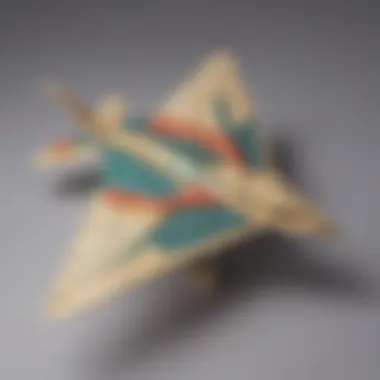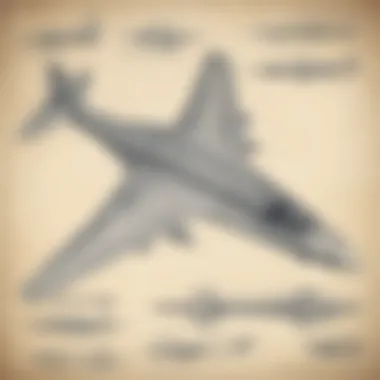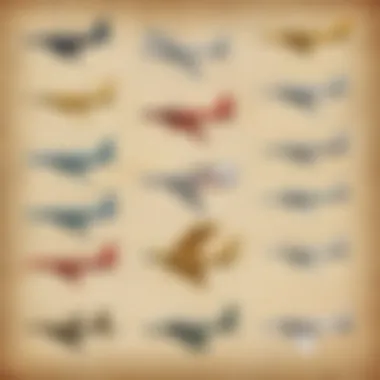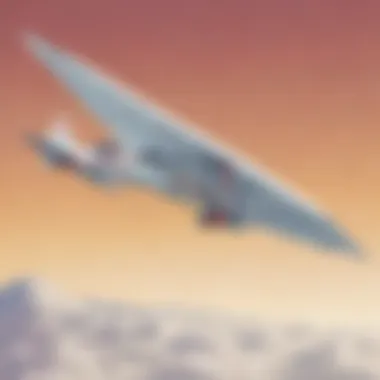Unveiling the Intriguing Universe of Paper Flight: A Deep Dive into Science, History, and Artistry


Science Fun Facts
Are you ready to explore the enchanting world of paper flight? Let's kick off with some riveting science fun facts that will unveil the secrets behind the aerodynamic marvels of paper airplanes. Did you know that the farthest distance flown by a paper aircraft is over 226 feet? Yes, that's right! Imagine a humble sheet of paper soaring through the air for such an astonishing distance, defying gravity with grace. Let's delve deeper into the realm of paper flight with these whimsical and mind-boggling trivia.
Discover the Wonders of Science
As we venture further into the intricacies of paper flight, let's uncover the wonders of science that make this seemingly simple activity a marvel of physics and creativity. From exploring various scientific concepts like lift, drag, and thrust to witnessing educational videos and animations that elucidate the aerodynamic principles at play, prepare to be captivated by the intersection of artistry and scientific ingenuity. Discover the real-life applications of science as we unravel the magic behind crafting paper airplanes that glide effortlessly through the air with precision and grace.
Science Quiz Time
Are you up for a stimulating challenge? Engage in an interactive learning experience with our science quiz time segment, where you can put your knowledge to the test. From multiple choice questions that tease your understanding of aerodynamics to brain teasers and puzzles that spark creativity and critical thinking, immerse yourself in the fascinating realm of paper flight through gamification. Enrich your learning journey as you conquer each quiz, unlocking new depths of insight into the captivating world of paper aircraft.
Science Experiment Showcase
Prepare to embark on a hands-on journey of exploration with our science experiment showcase. Delve into fun and engaging experiments that illuminate the principles of flight, providing you with a firsthand experience of the scientific concepts at play. Follow step-by-step instructions, gather your materials from the comprehensive list provided, and remember to adhere to safety tips and precautions to ensure a secure and enjoyable learning adventure. Join us as we transform theory into practice, fostering a deep understanding of the enchanting world of paper flight through interactive experimentation.
Introduction to Paper Flight
Paper flight holds a unique allure that has transcended generations and cultures, captivating the imagination of individuals young and old. In this article, we delve into the intricate world of paper flight, unraveling the scientific principles, historical origins, and artistic nuances that underpin the creation and flight of paper airplanes. From understanding the fundamental tenets of aerodynamics to charting the evolution of paper aircraft designs, readers will be immersed in a fascinating journey that sheds light on the intricacies of achieving optimal flight performance using the simplest of materials.
Origins of Paper Flight
Early Beginnings
The dawn of paper flight traces back to ancient Asian civilizations, where adept craftsmen first experimented with folding paper into rudimentary flying structures. These early beginnings laid the foundation for the development of more sophisticated paper airplanes we see today. The appeal of early paper flight lies in its simplicity and accessibility, offering enthusiasts a canvas to explore creativity and engineering prowess using minimal resources. Despite its humble origins, early paper flight shapes the very essence of this article, emphasizing the intrinsic connection between innovation and tradition within the realm of paper aviation.
Cultural Significance
Across various cultures worldwide, paper flight symbolizes more than just a recreational pastime—it embodies a medley of historical, artistic, and even spiritual significance. The cultural resonance of paper flight underscores its universal appeal, transcending language barriers to inspire a sense of wonder and ingenuity among enthusiasts. Incorporating the cultural aspects of paper flight enriches the discourse within this article, shedding light on the deep-rooted traditions and customs that have been intertwined with the craft of paper aviation over the centuries.
Principles of Aerodynamics
Lift and Drag
The interplay between lift and drag serves as the cornerstone of aerodynamic principles in paper flight, dictating the flight characteristics and efficiency of paper aircraft. Understanding how these aerodynamic forces interact is crucial for aspiring paper aviators seeking to optimize their designs for superior performance and stability. Delving into the nuances of lift and drag within the context of paper flight unveils a realm of scientific inquiry that piques the curiosity of enthusiasts, driving them to refine their creations through meticulous experimentation and analysis.
Thrust and Weight
In the realm of paper flight, the balance between thrust and weight directly influences the propulsion and maneuverability of paper aircraft designs. Balancing these opposing forces is a delicate art that enthusiasts master through iterative design iterations and flight testing. Exploring the dynamics of thrust and weight in paper aviation sheds light on the mechanical intricacies that underpin the sustainable flight of paper airplanes, offering a profound appreciation for the symbiotic relationship between propulsion and gravity in achieving airborne grace.
Effects of Shape and Folds
The structural design of paper airplanes directly influences their aerodynamic performance, with the effects of shape and folds playing a pivotal role in determining flight stability and distance. Analyzing how variations in shape and folding techniques impact aerodynamic efficiency provides enthusiasts with valuable insights into enhancing the flight characteristics of their creations. Examining the nuanced effects of shape and folds on paper aircraft empowers enthusiasts to experiment with novel design approaches, fostering a culture of innovation and ingenuity within the realm of paper aviation.
Materials for Paper Aircraft


Types of Paper
The choice of paper in constructing paper aircraft significantly impacts the overall flight performance and durability of the final design. Various types of paper, ranging from lightweight to heavyweight cardstock, offer distinct advantages and considerations for aspiring paper aviators. Each type of paper presents unique properties that enthusiasts can leverage to tailor their designs according to flight objectives and artistic preferences. Exploring the characteristics of different paper types guides enthusiasts in selecting the most suitable material for their projects, ensuring optimal flight performance and structural integrity.
Additional Components
Innovations in paper flight extend beyond the paper itself, introducing additional components such as weights, adhesives, and embellishments to enhance the functionality and visual appeal of paper aircraft. Incorporating supplementary components opens up a realm of creative possibilities for enthusiasts, enabling them to customize their designs with precision and ingenuity. Experimenting with various components allows enthusiasts to push the boundaries of traditional paper aviation, blurring the lines between art and engineering in crafting unique and efficient flying machines.
Crafting Paper Airplanes
Crafting paper airplanes is a fundamental aspect of the paper flight experience. Within the vast universe of paper flight, mastering the art of folding intricate designs plays a crucial role in achieving optimal aerodynamic performance and flight characteristics. Paper airplanes are not just simple toys but intricate creations that require precision and attention to detail. Understanding the principles of aerodynamics and how folds and shapes influence flight dynamics is key to crafting paper airplanes that soar gracefully through the air.
Basic Folding Techniques
Standard Designs
Standard designs are the building blocks of paper aviation. These tried and tested models serve as the foundation for more complex creations. The simplicity of standard designs lies in their ease of folding and their predictable flight patterns. By mastering these basic folds, enthusiasts can grasp the fundamentals of aerodynamics and experiment with modifications to enhance performance. While standard designs may seem basic, their importance cannot be overstated as they form the basis for all paper aircraft experimentation and innovation.
Advanced Patterns
Advanced patterns represent the pinnacle of paper airplane design. These intricate folds and patterns push the boundaries of aerodynamics, allowing enthusiasts to explore complex flight maneuvers and unique features. Advanced patterns require a keen understanding of geometry and airflow dynamics to create models that exhibit exceptional performance. While challenging to master, advanced patterns offer unparalleled creativity and innovation in the realm of paper aircraft design.
Fine-Tuning for Performance
Balance and Stability
Achieving optimal balance and stability is paramount in enhancing a paper airplane's performance. By meticulously adjusting the distribution of weight and refining the center of gravity, enthusiasts can ensure smooth and stable flight paths. Balance and stability also play a significant role in mitigating drag and optimizing the efficiency of paper airplanes. Fine-tuning these aspects allows for greater control during flight, enabling pilots to execute precise maneuvers with ease.
Trimming for Flight Path
Trimming for the flight path involves refining the control surfaces of a paper airplane to influence its trajectory. By adjusting elements such as wing angles and flaps, enthusiasts can customize the flight characteristics of their creations. Trimming enables pilots to fine-tune the lift and drag forces acting on the aircraft, resulting in enhanced maneuverability and performance. Understanding how trimming affects flight behavior is essential for optimizing a paper airplane's capabilities.
Innovative Design Approaches
Inspired by Nature
Drawing inspiration from the natural world, paper airplane enthusiasts can create designs that mimic the aerodynamic properties of birds and other flying creatures. These nature-inspired models often exhibit unique flight characteristics, such as increased lift or stability. By emulating biological structures and behaviors, designers can unlock new possibilities in aerodynamics and push the boundaries of traditional paper aircraft design.
Engineering Principles
Applying engineering principles to paper airplane design introduces a scientific approach to optimization. By incorporating concepts such as lift-to-drag ratios and structural integrity, enthusiasts can create models that maximize performance efficiency. Engineering-informed designs prioritize functionality and performance, making use of empirical data and calculations to achieve desired flight outcomes. Embracing engineering principles offers a systematic methodology for enhancing the quality and functionality of paper airplanes.
Flight Testing and Optimization
Flight testing and optimization play a pivotal role in the realm of paper flight, serving as the crucible where theory meets practice. This section delves into the crucial aspects of testing and fine-tuning paper aircraft to achieve optimal performance and flight characteristics. By meticulously analyzing and adjusting various elements of paper airplanes, enthusiasts and engineers can unlock the secrets to enhancing flight efficiency and aerodynamic stability.


Flight Testing Methods
Flight testing methods encompass a diverse range of techniques tailored to examine and enhance the flight capabilities of paper aircraft. These methods serve as essential tools for iteratively improving design and performance, ensuring that each fold and crease contributes harmoniously to a successful flight.
Indoor Tests
Indoor testing holds a prominent position in the domain of paper flight experimentation. With controlled environments offering stability and predictability, indoor tests enable enthusiasts to scrutinize the flight behavior of their creations without external interference. The confined spaces of indoor settings accentuate the nuances of aerodynamics and design, providing valuable insights into lift, drag, and stability. Despite its advantages, indoor testing may limit the assessment of long-distance flights due to spatial constraints, necessitating a combination of indoor and outdoor testing for comprehensive analysis.
Outdoor Experiments
Outdoor experiments present a contrasting yet equally vital dimension to flight testing. By taking paper aircraft into the open skies, testers can gauge their performance under natural elements such as wind conditions and varying terrains. Outdoor experiments offer a broader perspective on flight dynamics, allowing for evaluations of distance coverage and maneuverability. While outdoor testing may introduce additional variables that challenge flight predictability, it remains indispensable for assessing real-world applications and refining designs for diverse flying conditions.
Adjustments for Performance
Fine-tuning paper airplanes for optimal performance involves a nuanced approach that considers various factors influencing flight behavior. From launching techniques to modifications tailored for specific flight objectives, the art of adjustments plays a decisive role in enhancing aerodynamic efficiency and achieving flight stability.
Launching Techniques
Perfecting launching techniques holds the key to initiating a successful flight trajectory. By mastering the art of launch angles, velocity, and direction, enthusiasts can optimize the initial thrust and ascent of their paper aircraft. Each launch technique imparts a unique spin or trajectory to the flight, influencing stability and distance coverage.
Modifications for Distance or Stunts
Adapting paper airplanes for long-distance flights or acrobatic maneuvers necessitates strategic modifications to the design and weight distribution. Tweaking wingspan, elevators, or adding stabilizing components can transform a standard paper aircraft into a specialized performer tailored for specific flight objectives. However, such modifications require careful calibration to balance aerodynamic enhancements with structural integrity and weight considerations.
Recording and Analyzing Results
Capturing and analyzing flight data constitutes a crucial phase in the optimization process of paper aircraft. By documenting performance metrics and observing flight patterns, enthusiasts can discern actionable insights for refining design elements and implementing targeted improvements.
Flight Data
Flight data serves as the cornerstone of informed decision-making in paper flight experimentation. By recording parameters such as flight duration, height, and stability, testers can quantify the performance of their aircraft objectively. Analyzing flight data enables enthusiasts to identify trends, anomalies, and areas for optimization, paving the way for iterative enhancements.
Improvement Strategies
Crafting effective improvement strategies hinges on a meticulous evaluation of flight data and observational insights. By formulating targeted adjustments based on recorded performance metrics, enthusiasts can enhance the aerodynamic efficiency, stability, and maneuverability of their paper airplanes. Implementing strategic improvements demands a balanced approach that considers both empirical data and qualitative observations to optimize flight performance.
Exploring Paper Flight Beyond Airplanes
Paper flight extends far beyond the realm of traditional airplanes, encompassing a diverse array of creations that push the boundaries of imagination and aerodynamics. This section delves into the significance of exploring paper flight beyond airplanes within the broader context of this article. By shifting the focus from conventional designs to innovative concepts like paper helicopters and flying creatures, readers are exposed to a new dimension of creativity and engineering. Understanding these unconventional paper aircraft not only expands one's repertoire of paper-folding skills but also opens doors to artistic expressions and scientific exploration that transcend the ordinary.
Paper Helicopters
Design Variations
Design variations in paper helicopters introduce a stimulating twist to the art of paper flight. These variations encompass modifications in rotor sizes, blade angles, and fuselage designs, each contributing uniquely to the aesthetics and aerodynamics of the helicopter. The key characteristic of design variations lies in their ability to customize flight behavior based on the creator's intentions. This flexibility makes design variations a popular choice for enthusiasts seeking to experiment with different flying styles or adapt helicopters to specific flight challenges. While diverse design options offer creativity and adaptability, they may also pose challenges in fine-tuning for optimal performance in this article.


Flight Characteristics
The flight characteristics of paper helicopters play a pivotal role in determining their behavior in the air. These characteristics, including stability, hover capacity, and maneuverability, significantly influence the flight experience and performance of the helicopter. Highlighting the crucial balance between lift and drag, paper helicopters exhibit unique flight patterns that showcase the intricacies of aerodynamics. Understanding these flight characteristics not only enhances one's knowledge of aviation principles but also fosters an appreciation for the dynamics of paper aircraft. While favorable flight characteristics can elevate the experience of flying paper helicopters, inherent limitations may require careful consideration and adjustments for optimal flight in this article.
Flying Creatures
Birds and Insects
The embodiment of elegance and agility, paper models of birds and insects bring forth the beauty of nature in flight. By mimicking the aerodynamic profiles and behavioral patterns of real creatures, these paper creations transcend mere artistry to become lessons in biomimicry and design innovation. The key characteristic of birds and insects lies in their ability to inspire creativity and curiosity, sparking interest in both aviation enthusiasts and nature lovers. While replicating the flight mechanics of living organisms presents exciting challenges and learning opportunities, it also requires attention to detail and precision to truly capture the essence of these flying creatures in this article.
Artistic Creations
Paper flight evolves into a form of artistic expression with creations that merge aesthetics and aerodynamics seamlessly. Artistic creations go beyond functional aircraft to embody emotions, narratives, and abstract concepts through paper folding and design. The key characteristic of artistic creations is their capacity to evoke feelings and provoke thoughts through visual storytelling and imaginative interpretations. While artistic freedom allows for unlimited possibilities in design and presentation, translating artistic vision into flight-worthy models demands a delicate balance between form and function. Navigating this intersection between art and science poses both challenges and rewards for creators looking to infuse their paper flights with artistic flair in this article.
Challenges and Competitions
Distance Challenges
In the realm of paper flight, distance challenges measure the capability of paper aircraft to cover extended distances with precision and stability. These challenges test the aerodynamic efficiency, structural integrity, and launching techniques of paper planes in a competitive setting. The key characteristic of distance challenges lies in their emphasis on design optimization for long-distance flight, encouraging participants to experiment with various paper types, folds, and aerodynamic principles. While achieving remarkable distances showcases skill and ingenuity, mastering the delicate balance between lift and drag remains a constant challenge for participants aiming to excel in distance contests in this article.
Acrobatics Contests
Acrobatics contests inject an element of thrill and showmanship into the world of paper flight, challenging participants to perform aerial maneuvers with grace and precision. These contests highlight the agility, stability, and creativity of paper aircraft as they loop, glide, and flip through the air. The key characteristic of acrobatics contests lies in their fusion of artistry and technical skill, requiring contestants to balance creative choreography with aerodynamic precision. While executing jaw-dropping stunts captivates audiences and judges alike, the margin for error in acrobatics contests underscores the need for meticulous planning and flawless execution to dazzle in this article.
The Future of Paper Flight
The section on The Future of Paper Flight within this captivating article presents an intriguing exploration of what lies ahead in the realm of paper flight. As we look forward, the evolution of paper flight extends beyond traditional boundaries, embracing innovation and advancement in various aspects. The agility of paper airplanes in the coming years will likely be influenced significantly by emerging technologies and educational paradigms.
Technological Advancements
Digital Modeling
Digital Modeling stands as a pivotal advancement poised to revolutionize the craft of paper flight, offering a streamlined approach to design and testing. By harnessing digital tools, enthusiasts can now simulate and iterate their designs virtually before crafting physical prototypes. This feature enables precise adjustments and customization tailored to specific flight objectives, enhancing overall efficiency and performance. While Digital Modeling presents an efficient and practical approach to design, its reliance on technological infrastructure may pose challenges in accessibility and hands-on learning experiences.
3D Printing Applications
3D Printing Applications introduce a new dimension to paper aircraft construction, enabling intricate designs and structures previously unattainable through traditional methods. This technology facilitates the creation of complex components with high precision, elevating the intricacy and performance potential of paper aircraft. The adaptability of 3D Printing in material selection and design iterations further enhances the creative possibilities for enthusiasts. However, the cost associated with 3D Printing equipment and materials may present limitations for widespread adoption in educational settings.
Educational Impact
In examining the Educational Impact of paper flight, it becomes evident that the fusion of STEM principles with hands-on experimentation offers a fertile ground for learning and skill development. Stemming from a blend of Science, Technology, Engineering, and Mathematics, STEM Learning cultivates a holistic understanding of aerodynamics, material science, and design principles. This interdisciplinary approach not only nurtures critical thinking and problem-solving skills but also fosters creativity and innovation in young learners. Nevertheless, the implementation of STEM Learning in educational contexts may require specialized training and resources, potentially hindering its integration into standard curricula.
Innovative Teaching Methods
In the realm of paper flight, Innovative Teaching Methods play a crucial role in engaging students and enhancing learning outcomes. By leveraging interactive techniques such as collaborative projects, gamified challenges, and experiential workshops, educators can nurture a passion for exploration and discovery among learners. The dynamic nature of these methods encourages active participation and skill acquisition, aligning with diverse learning styles and preferences. However, the effective implementation of Innovative Teaching Methods demands dedicated planning and resource allocation, raising considerations around scalability and instructor training.
Artistic Expressions
Exploring the intersection of art and aviation, Artistic Expressions within paper flight encapsulate a realm of boundless creativity and self-expression. Installation Art introduces immersive experiences through large-scale displays that transcend conventional boundaries, inviting viewers into a multi-sensory exploration of flight aesthetics and mechanics. While Installation Art resonates with visual learners and artistic sensibilities, its logistical requirements and spatial constraints may present logistical challenges in educational settings.
Performance Art
Performance Art in the context of paper flight ignites imaginations and pushes the boundaries of traditional flight exhibitions through dynamic and interactive showcases. By integrating elements of theater, music, and choreography into flight demonstrations, Performance Art adds a layer of narrative and emotion to the flight experience, captivating audiences of all ages. The fusion of performance elements with aeronautical feats offers a holistic approach to appreciating the artistry and technical precision of paper flight. However, the coordination and logistical complexities of staging performance-based events may require additional planning and resources, posing considerations for implementation and sustainability.







